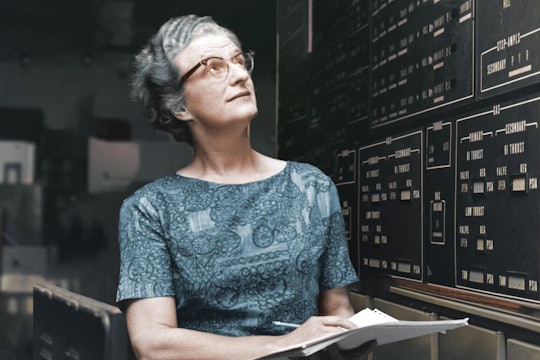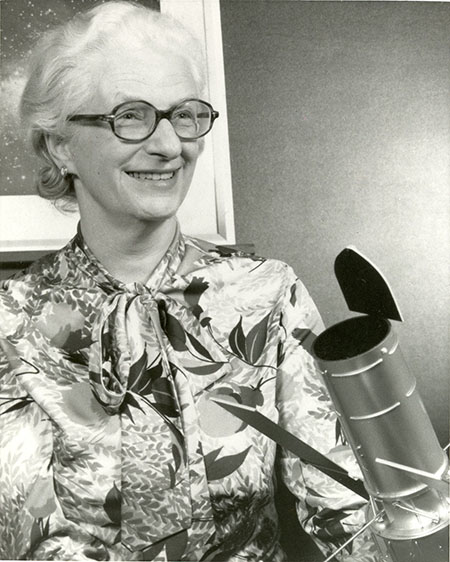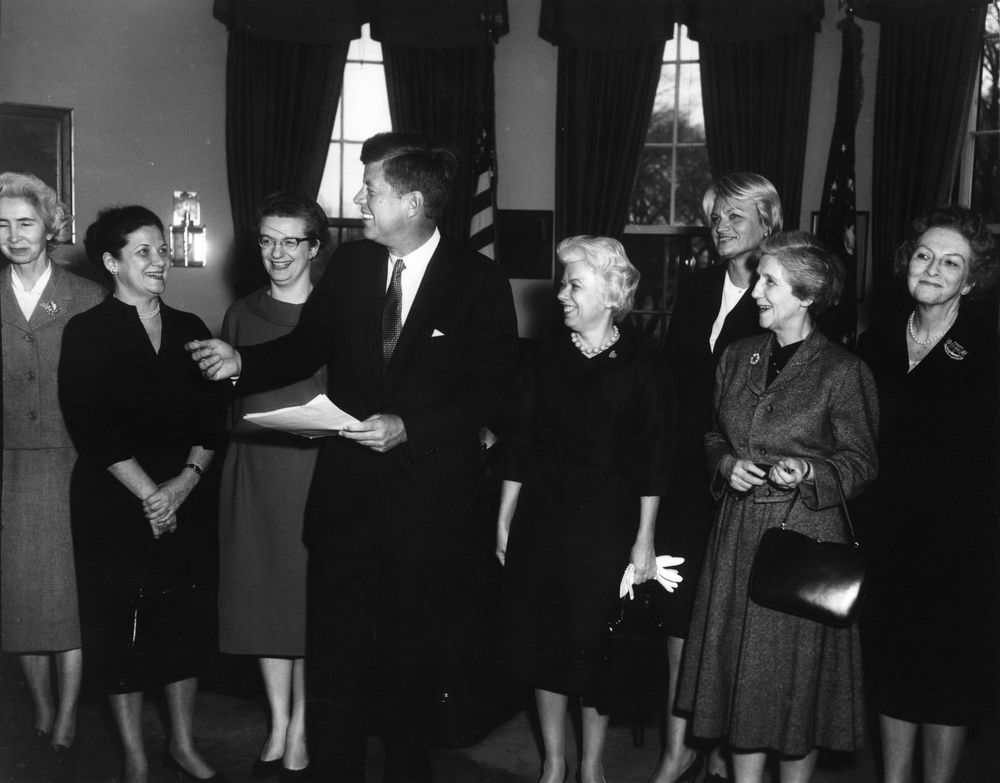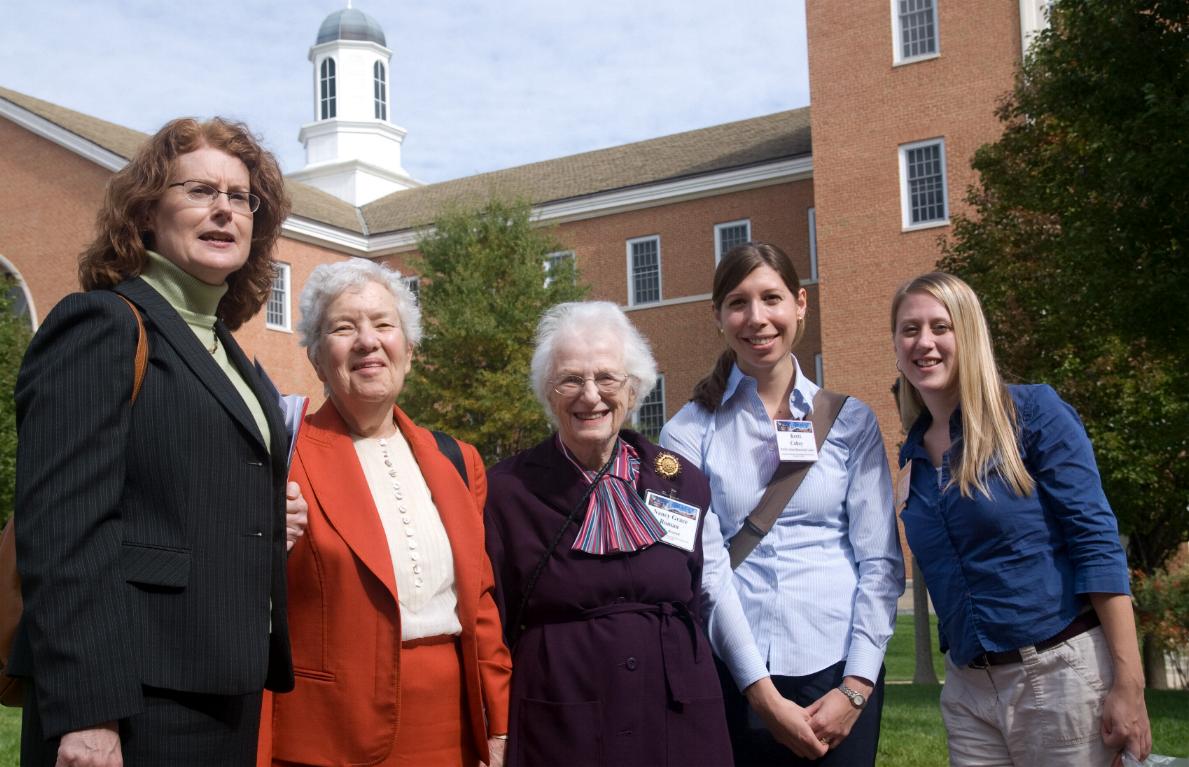
Via Wikimedia
Meet Nancy Grace Roman, the "mother" of the Hubble Space Telescope
She discovered fundamental truths about stars and galaxies, and also shaped NASA into what we know it as today
Today we take for granted that part of NASA’s job is to do astronomy, like with the legendary Hubble Space Telescope and the upcoming James Webb Space Telescope. But that wasn’t always the case — and we have astronomer Nancy Grace Roman to thank for shaping the space agency that it is today.
Roman, known now as the “mother of Hubble”, was born in Tennessee in 1925 and grew up as the quintessential kid with their head tilted up at at the stars. Her mother took her on walks to observe nature, showing her constellations at night, while her scientist father answered her curious questions. Of course, her favorite thing to draw as a kid was the Moon.
But, like many women at the time, her budding interest in STEM was discouraged. Her high school guidance counselor advised her to take more Latin instead of advanced math classes, since it was more “ladylike” to do so. When she finally made it to Swarthmore College, Roman had a rough start, recounting how, “the Dean of Women interviewed each freshman girl. If she failed to convince her not to major in science or engineering, the Dean had nothing more to do with her for the next four years.” With a series of poor physics professors, she was left to figure out a lot of the content on her own. Her first bit of backhanded encouragement, though, came from one of these professors, who said, “I usually try to discourage girls from going into physics, but I think maybe you might make it.”
Roman did, in fact, make it. She earned her PhD in 1949 from University of Chicago, working at the nearby Yerkes Observatory. Despite a lackluster thesis advisor, she stayed on after graduation to work as an assistant professor and continue her research on the properties of stars at Yerkes. Some of her research from this time forms the foundations of our current knowledge about stars and how our galaxy formed. She found that many of the common types of stars around us are different ages and observed the compositions of stars at the center of our Milky Way, giving the first clues about galaxy formation. Roman measured spectra of a whole catalog of stars, traveling to many observatories: Mount Wilson in Pasadena, Lick near San Jose and McDonald in Texas. For several years, she spent one-third of each year at McDonald, observing on every clear night (something an astronomer nowadays could only dream of).

Nancy Grace Roman
NASA
Yet, her job at Yerkes was unfulfilling, mostly due to the unequal treatment of female scientists. Her pay was less than two-thirds of what the men earned, a fact unsatisfyingly explained by an administrator who said, “We don’t discriminate against women — we can just get them for less.” She knew she had no chance of getting tenure due to discrimination, and her relationship with her PhD advisor remained rocky. Even people outside academia showed their discomfort with her role: “One reporter when told I was an astronomer replied, 'You can't be. You don't have a beard.' Another reporter, from a small paper in a neighboring town, was noticeably uncomfortable talking with a woman.”
Roman knew she needed to leave academic science, but she didn’t want to abandon astronomy altogether, leading her to a civil service job at the US Naval Research Lab (NRL) in Washington, D.C. In 1958, shortly after she began working at NRL, NASA was founded — and a substantial portion of NRL was transferred to NASA to form the Goddard Space Flight Center, which today still works on many of NASA’s big astronomy missions. Roman was asked to set up a program in space astronomy, an opportunity that she described as, “the chance to start with a clean slate to map out a program that I thought would influence astronomy for fifty years...more than I could resist.” In 1959, she officially joined NASA as the first Head of Observational Astronomy.
The environment in the early days of the agency was electric: "Everyone was gung ho,” she recalled. “There was no bureaucracy...Once, I wanted to do something unusual. I no longer remember what it was, but I called someone in the grants office to find out if I could do it. The reply was memorable: ‘Don't ask me what you can do. Tell me what you want to do. It is up to me to find a way.’” While famously NASA was working on human spaceflight and Moon landings, Roman turned her attention to developing the first space observatories.
At the time, people hadn’t yet figured out how to accurately point a telescope on a satellite, but they knew there would be serious benefits to getting out of Earth’s pesky atmosphere, since there are some wavelengths you can’t see from the ground because they’re absorbed before they reach us. Soon promoted to Chief of Astronomy, she oversaw the first orbiting observatory: a project known as the Orbiting Solar Observatories (OSO). After the success of those missions, her team soon followed up with the Orbiting Astronomical Observatories (OAO), the first space observatory looking at distant stars.

Nancy Grace Roman (third from the left) standing next to President John F. Kennedy and other recipients of 1962 Federal Woman’s Award
Via Wikimedia
These projects, shepherded by Roman, were the predecessors of modern space telescopes like Hubble, Kepler, Spitzer, and more. And the OAO projects did some remarkable science, too — they observed over 1,200 objects in ultraviolet light for the first time, found that comets have huge halos of hydrogen, and more.
But the OSO and OAO telescopes only observed in ultraviolet light — what about a regular, visible light telescope in space? Astronomer Lyman Spitzer had written a paper describing the science that could be done with a small four-meter space telescope, starting the conversation around space observatories.
Roman was convinced of the value of such a space observatory and lobbied to fund the project, despite significant pushback. Roman said, “At one point, Senator William Proxmire, noted for ridiculing government funding that he considered frivolous, asked NASA why the American taxpayer should support an expensive telescope. I did a back-of-envelope calculation and determined that for the cost of one night at the movies, every American would have fifteen years of exciting discoveries.” Her calculations convinced him.
In 1971, Roman assembled a group to design the systems that would become the basis of the Hubble Space Telescope, laying the foundations for this monumental mission. Before her retirement, she helped create the Space Telescope Science Institute, an institution dedicated to managing space telescopes and their data (beginning with Hubble).

Nancy Grace Roman (center) with astronomer Vera Rubin (second from left)
Via Wikimedia
The Hubble Space Telescope went on to be one of the most important, revolutionary changes in astronomy. A telescope above Earth’s atmosphere was able to take images of things we’d never seen before: far away galaxies, detailed photos of stars being born, planets around other stars. Data from the Hubble Space Telescope taught us that each galaxy has a supermassive black hole at its center, that galaxies merge in cosmic spectacles, and that our universe is getting bigger at an ever increasing rate. Although she retired in 1979, far before Hubble’s launch in 1990, her role in creating the first orbiting astronomical observatories — Hubble’s predecessors that proved science could be done in orbit — earned her the nickname “the mother of Hubble.”
Roman earned many honors for her foundational contributions to astronomy and years of civil service with NASA: the Federal Women’s Award, multiple honorary doctorates, NASA’s Exceptional Scientific Achievement award, and even an asteroid named after her. She called her likeness in LEGO form by far the most fun honor she had received, even personally signing hundreds of boxes.
Nancy Grace Roman passed away in 2018, but her legacy lives on. In 2020, the NASA telescope formerly known as WFIRST (the Wide Field InfraRed Survey Telescope) was named in her honor, now known as the Nancy Grace Roman Space Telescope. It has a mirror the same size as Hubble’s and two new instruments to go along with it: a wide field camera with 100 times the field of view Hubble had, and a coronagraph to search for planets around other stars. It’ll hopefully reveal new insights about dark energy, exoplanets, and more. Former NASA Administrator Jim Bridenstine said, “It is because of Nancy Grace Roman’s leadership and vision that NASA became a pioneer in astrophysics and launched Hubble, the world’s most powerful and productive space telescope. I can think of no better name for WFIRST, which will be the successor to NASA’s Hubble and Webb Telescopes.”
.jpeg)
Nancy Grace Roman views the still under construction James Webb Space Telescope in 2017
Via Wikimedia
Although she made history as one of the first female NASA executives, her legacy truly centers around her scientific work — how she was at the forefront of astronomy, with a new vision of what could be for the future. David DeVorkin, senior curator of the National Air and Space Museum, remarked that, “she had that very, very large egalitarian view of how to make space astronomy part of astronomy, and I think that is a very important legacy.”
Ahead of her time — as a woman a scientist before that role was widely accepted, as an observational astronomer before the digital age — Nancy Grace Roman shaped the field of astronomy, enabling decades of scientific discovery not only with Hubble, but with all space telescopes, forever changing our understanding of our place in the universe.
